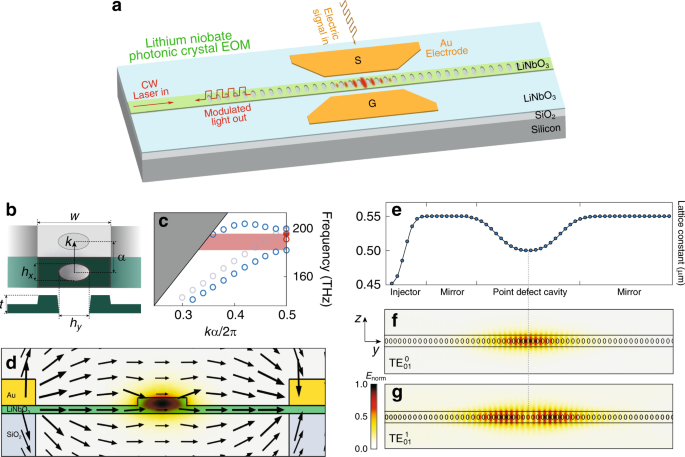(Photonics researchers report breakthrough in miniaturizing light-based chips)
2020/8/27 アメリカ合衆国・ロチェスター大学

・ ロチェスター大学が、高速作動、エネルギー高効率で世界最小サイズのニオブ酸リチウム(LN)電気光学モジュレーター(EOM)を開発。
・ 同デバイスは、シリコン基板上の二酸化ケイ素(SiO2)層と LN の薄膜を結合したもの。回路中の光伝送を制御する EOM は、フォトニックチップの主要なコンポーネント。
・ コンピューティングや信号処理で光を利用するフォトニック集積回路では、電気を利用する従来型回路に比べ、より優れた作動速度、広い周波数帯域や高いエネルギー効率が期待できるが、電子回路が独占するコンピューティングや他のアプリケーションで競合できるほどの小型化が進んでいない。
・ 今回の研究結果は、データ通信、マイクロ波フォトニクスや量子フォトニクス等の幅広いアプリケーションで不可欠となる、大規模な LN フォトニック集積回路実現に不可欠な基盤を築くものと考える。
・ LN はフォトニクス研究開発で主力となる材料系となっているが、バルクの結晶または薄膜プラットフォームによる現在の LN フォトニックデバイスはサイズが大きく小型化が困難なため、モジュレーション効率、エネルギー消費や回路集積の度合いが制限されている。高精度の高品質ナノスケールフォトニック構造設計が重要な課題となっている。
・ 新 LN モジュレーターは、以前に開発した LN フォトニックナノキャビティ―(フォトニックチップの主要なもう一つのコンポーネント)をベースとしたもの。サイズが約 1μm のナノキャビティ―は、室温下にて2~3 個の光子で波長を調整する。モジュレーターは、ナノキャビティ―と共にナノスケールのフォトニックチップ製造に利用できる。
・ 本研究は、米国立科学財団(NSF)、米国防省威嚇削減局(DTRA)および米国防高等研究計画局(DARPA)の資金により実施された。
URL: https://www.rochester.edu/newscenter/photonics-researchers-report-breakthrough-inminiaturizing-light-based-chips-449382/
<NEDO海外技術情報より>
(関連情報)
Nature Communications 掲載論文(フルテキスト)
Lithium niobate photonic-crystal electro-optic modulator
URL: https://www.nature.com/articles/s41467-020-17950-7
Abstract
Modern advanced photonic integrated circuits require dense integration of high-speed electro-optic functional elements on a compact chip that consumes only moderate power. Energy efficiency, operation speed, and device dimension are thus crucial metrics underlying almost all current developments of photonic signal processing units. Recently, thin-film lithium niobate (LN) emerges as a promising platform for photonic integrated circuits. Here, we make an important step towards miniaturizing functional components on this platform, reporting high-speed LN electro-optic modulators, based upon photonic crystal nanobeam resonators. The devices exhibit a significant tuning efficiency up to 1.98 GHz V−1, a broad modulation bandwidth of 17.5 GHz, while with a tiny electro-optic modal volume of only 0.58 μm3. The modulators enable efficient electro-optic driving of high-Q photonic cavity modes in both adiabatic and non-adiabatic regimes, and allow us to achieve electro-optic switching at 11 Gb s−1 with a bit-switching energy as low as 22 fJ. The demonstration of energy efficient and high-speed electro-optic modulation at the wavelength scale paves a crucial foundation for realizing large-scale LN photonic integrated circuits that are of immense importance for broad applications in data communication, microwave photonics, and quantum photonics.



